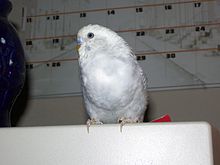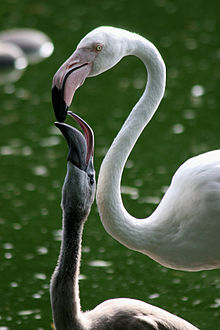- Crop (anatomy)
-
This article is about the digestive croup. For the top of the hindquarters, also known as the croup, see Rump (animal).
 A male Budgerigar with a full crop after feeding.
A male Budgerigar with a full crop after feeding.
A crop (or croup sometimes called a craw) is a thin-walled expanded portion of the alimentary tract used for the storage of food prior to digestion that is found in many animals, including gastropods, earthworms,[1] leeches,[2] insects[3], birds, and even some dinosaurs.
Contents
Bees
Cropping is used by bees to temporarily store nectar of flowers. When bees "suck" nectar, it is stored in their crop.[4]
Birds
In a bird's digestive system, the crop is an expanded, muscular pouch near the gullet or throat. It is a part of the digestive tract, essentially an enlarged part of the esophagus. As with most other organisms that have a crop, the crop is used to temporarily store food. Not all birds have a crop. In adult doves and pigeons, the crop can produce crop milk to feed newly hatched birds.[5]
Scavenging birds, such as vultures, will gorge themselves when prey is abundant, causing their crop to bulge. They subsequently sit, sleepy or half torpid, to digest their food.
Most raptors have one; like falcons, hawks, eagles and vultures (as stated above) but owls do not.
See also
- Esophagus
- Proventriculus
- Gizzard
- Gular pouch, in bird anatomy, a flap generally used to store fish and other prey while hunting
References
- ^ "Worm World: About Earthworms". http://yucky.discovery.com/flash/worm/pg000102.html. Retrieved 2008-12-16.
- ^ Sawyer, Roy T (PDF). Leach Biology and Behaviour, Volume II. http://www.biopharm-leeches.com/pdf/bioandbehav.pdf. Retrieved 2008-12-16.
- ^ "Insect Identification: Digestive System". http://insectspedia.blogspot.com/2010/10/digestive-system.html. Retrieved 2011-01-18.
- ^ "Honeybee Biology". 1994. http://plantphys.info/plants_human/bees/bees.shtml. Retrieved 2008-12-16.
- ^ Gordon John Larkman Ramel (2008-09-29). "The Alimentary Canal in Birds". http://www.earthlife.net/birds/digestion.html. Retrieved 2008-12-16.
External links

This veterinary medicine–related article is a stub. You can help Wikipedia by expanding it.


